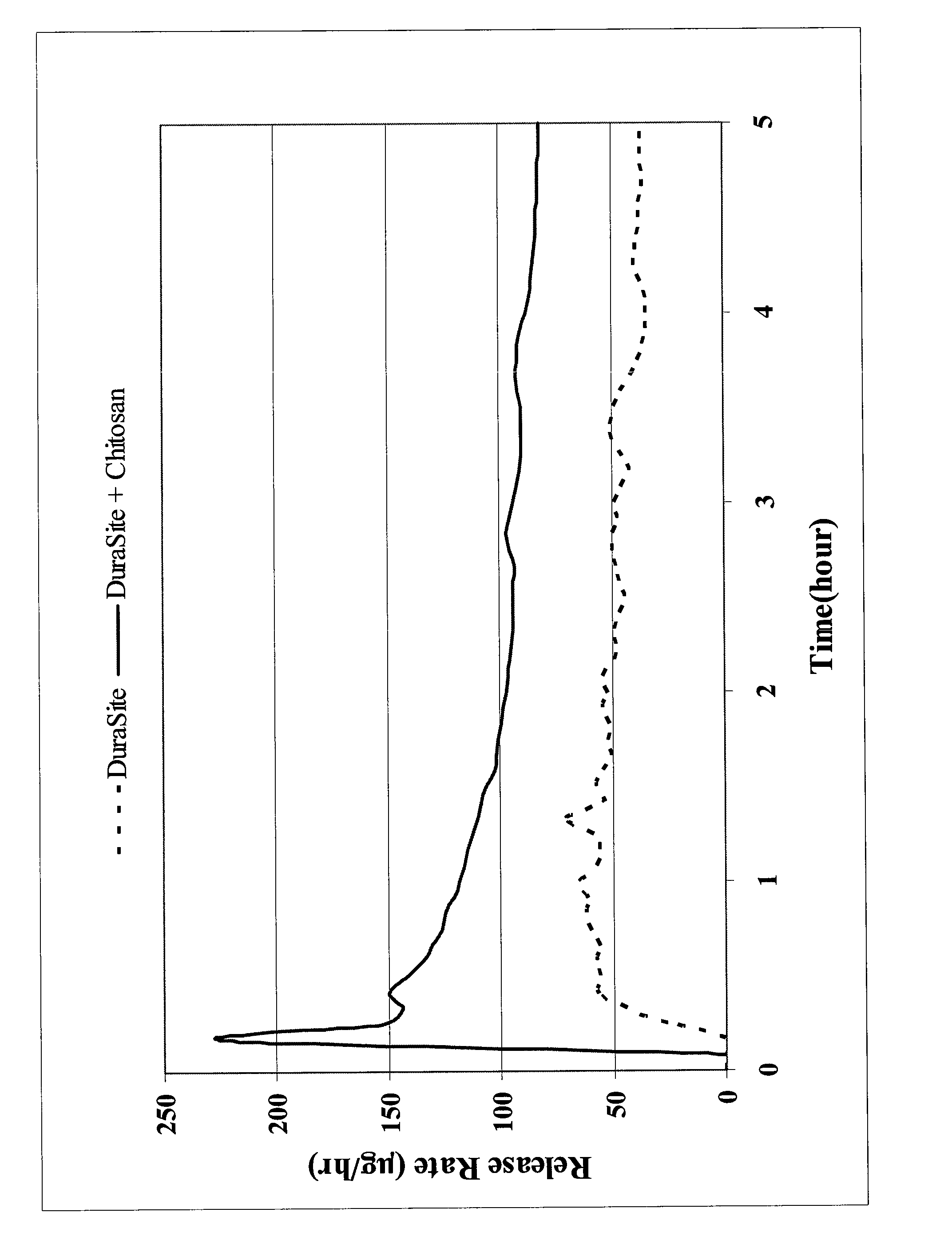Controlled-release ophthalmic vehicles
a technology of ophthalmic vehicles and ophthalmic mucosa, which is applied in the direction of drug compositions, peptide/protein ingredients, biocides, etc., can solve the problem that the drug delivery to the ocular mucosa faces the additional obstacle of various clearance mechanisms
- Summary
- Abstract
- Description
- Claims
- Application Information
AI Technical Summary
Benefits of technology
Problems solved by technology
Method used
Image
Examples
example i
Polymer Screening
[0069]This Example shows the varying effects of neutral, anionic and cationic additives to the viscosity of a commercially available carboxy-containing polymer ophthalmic vehicle, DURASITE®.
[0070]The screening study was conducted to identify a polymer that could significantly increase the viscosity of a carboxy-containing polymer ophthalmic vehicle. The test polymers included an anionic polymer (polyacrylic acid, 450 kDa), neutral polymer (polyvinyl alcohol, 5 kDa and 133 kDa, or polyethylene oxide 900 kDa) and a cationic polymer (chitosan 50-100 kDa and 1000-3000 kDa).
[0071]The test polymer was dissolved in a solution containing citric acid, sodium citrate, mannitol, BAC, and poloxamer 407. Polycarbophil was separately dispersed in a solution containing sodium chloride and edetate disodium dihydrate. The solutions were combined and adjusted to pH 5.0 and q.s.'ed to weight. Small aliquots of the formulation were obtained and the pHs were adjusted to their target val...
example ii
Chitosan Assessment
[0076]This Example shows the effect of chitosan concentration and molecular weight on the viscosity of DURASITE®.
[0077]Chitosan was dissolved in a solution containing citric acid, sodium citrate dihydrate, mannitol, and poloxamer 407. Polycarbophil was separately dispersed in a solution containing edetate disodium dihydrate and sodium chloride. The chitosan and polycarbophil solutions were brought to the same pH using either hydrochloric acid or sodium hydroxide. The solutions were then combined and water is added to weight. Small aliquots of the formulation were obtained and their pHs were adjusted to target values using sodium hydroxide. The viscosities of the resulting vehicles were tested on a rheometer at a shear rate of 12 cycles / second.
[0078]The effects of concentration and molecular weight on the viscosity of DURASITE® are presented in Table 3. Increasing the concentration of chitosan effectively increased the viscosity of DURASITE®. Similarly, increasing ...
example iii
Physical Stability of Chitosan / DURASITE® Formulation
[0081]This Example shows the physical stability of a DURASITE® vehicle containing 0.025% high molecular weight chitosan.
[0082]The DURASITE® vehicles formulated to target pHs of 5.0, 6.5, and 8.0 were filled into Type I glass vials and crimped with Teflon-coated rubber caps. The test samples were placed in stability chambers set at 5° C. and 25° C. The physicochemical attributes of the vehicle (i.e. viscosity, pH, osmolality) were tested on a monthly basis.
[0083]The physicochemical stability of the 0.025% chitosan in DURASITE® tested up to 2 months is shown in Table 3. Except for the viscosity of the pH 6.5 sample stored at 25° C., all physicochemical attributes of the other samples remained the same through 2 months at 5° C. and 25° C. The pH 6.5 stability sample stored at 25° C. for 1 month was shown to have a higher viscosity value than those at the other storage condition and time points and appeared to be an outlier.
[0084]
TABLE...
PUM
| Property | Measurement | Unit |
|---|---|---|
| particle size | aaaaa | aaaaa |
| particle size | aaaaa | aaaaa |
| molecular weight | aaaaa | aaaaa |
Abstract
Description
Claims
Application Information
 Login to View More
Login to View More - R&D
- Intellectual Property
- Life Sciences
- Materials
- Tech Scout
- Unparalleled Data Quality
- Higher Quality Content
- 60% Fewer Hallucinations
Browse by: Latest US Patents, China's latest patents, Technical Efficacy Thesaurus, Application Domain, Technology Topic, Popular Technical Reports.
© 2025 PatSnap. All rights reserved.Legal|Privacy policy|Modern Slavery Act Transparency Statement|Sitemap|About US| Contact US: help@patsnap.com

